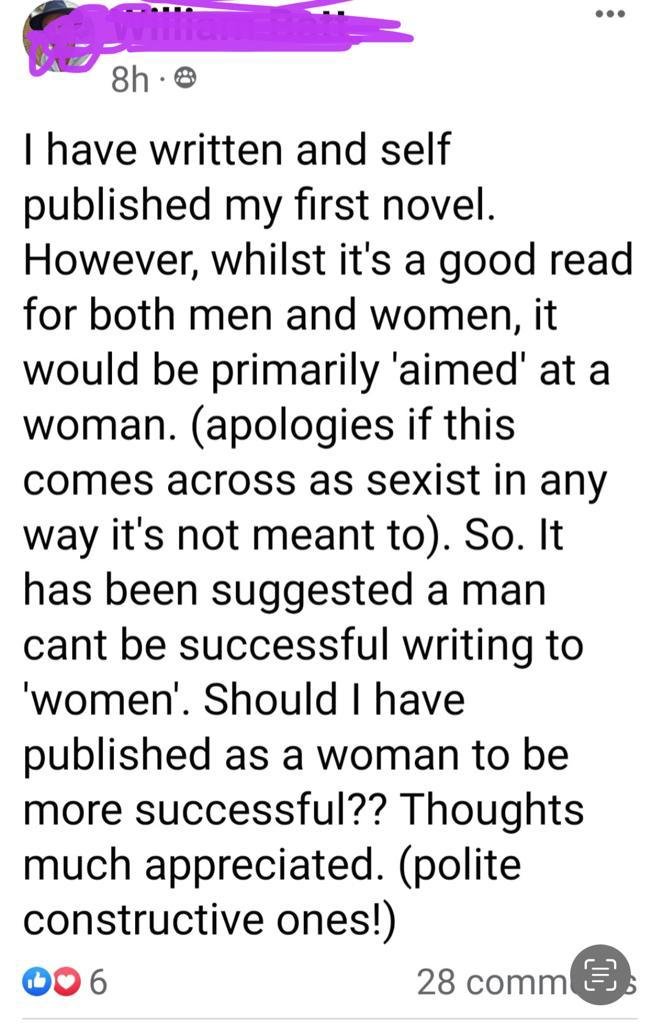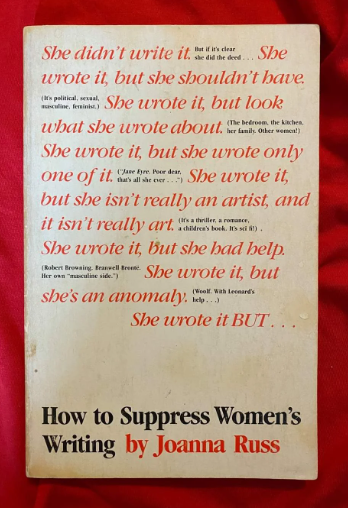Men Writing Women
You’ve seen it before.
Don’t do this.
You may even be familiar with the Twitter hashtag or the Subreddit. But before you go too far down those hilarious rabbit holes, let’s chat with some women writers about the main pitfalls they’ve seen when men (sometimes honestly trying their best) write women characters and what they can try to do better.
While it would be easy (and hilarious) to pull screenshots or quotes from the multitude of examples where this has gone laughingly wrong—women “holding in” their periods for greater effect, for instance—in this piece, we’re going to attempt to give some honest advice to the men trying to be better. (Although I can’t promise not to include screenshots as illustrations.)
A few general thoughts to remember:
Women are not usually fascinated or even preoccupied with their own breasts.
Women are not as visually motivated as men when it comes to sex.
Although society has deemed it more acceptable for a woman to express her emotions, most of us do not cry all the time.
Women have no control over the flow of their periods.
Now that that’s out of the way, let’s address the nuances of the typical #menwritingwomen pitfalls. “Put [your women characters] in heels and makeup if you choose,” says Audrey Lee, author of The Mechanics of Memory. “But don’t lead with their stunning beauty or, conversely, with their wish to be stunningly beautiful while comparing themselves to other women.” A major complaint that many of the women I talked to voiced was that often women are boiled down to their looks when written by men. And yes, we do want a mental picture of the character, but one tip is to check how you’ve described the other characters in your manuscript. Are the women the only ones getting their body parts in print?
“Limit physical description. Let your readers fill in the blanks,” advises J. L. Delozier, award-winning author of The Photo Thief, Con Me Once and the Persephone Smith thriller series. “It’s more fun that way for the reader and you avoid landmines that way. Never describe a woman’s breasts. Ever.” Once again for the people in the back. EVER.
“Tame the body parts references!” Agrees Melissa R. Collings, author of The False Flat (Coming in 2024). “Women don’t think about their breasts during a conversation. To women, our body parts are not novel wonders, they’re just body parts.”
Now let’s address the emotional elephant in the room. Women are often perceived as more emotional than men, which can lead to one of two undesirable outcomes:
The woman who cries at the drop of a hat.
The woman who’s “not like all the other girls” because she doesn’t cry at the drop of a hat.
While we’re on the subject, I’ll just leave this here.
It’s okay to have your characters cry, but almost every human who feels the urge to cry will try to repress it at first, sometimes successfully! Even in Ghost Tamer, which is a very emotional book about grief and loss, I pulled back on Raely’s actual tears, consciously limiting her crying scenes, and she fought against the emotion the whole way. (She is also pretty funny, in my opinion.)
“Make your female characters dimensional and complex,” says Lee. “Give them a depth and drive that comes from a universal human experience. Make their emotions, insecurities, and high EQ an asset and not a personality flaw that needs fixing.” Women are, first of all, humans. And every human has experienced every emotion by the age of ten. We may not have had the same experiences, but we’ve all experienced some kind of loss, grief, love, happiness, et cetera. My personal advice is to write the human first, and then see what additional information is needed.
“Run it by a woman if need be and check yo’self!” advises Collings.
“Avoid tropes – the voluptuous femme fatale. The perky—God, how I hate that word—best friend. When in doubt, ask a female friend/beta reader if your female character rings true,” adds Delozier. This is sound advice. Would you want to be condensed down to a stereotypical, football loving, beer guzzling, insensitive, inattentive Homer Simpson caricature? Get a woman friend or colleague to fact check you. And not a romantic partner or your mother. They’re too close to you and have a higher probability of empathetically reading the ‘intent’ behind your words. Get someone who can be objective.
Jackie Johnson, author of Bladestay also advises against adding women characters who “exist only to move the plot of the male character forward.” She suggests checking the Bechdel and Mako Mori tests to see how you’re doing there.
Writer MT Cozzola has some practical advice. “What I really think about is how we can all write better characters whose identity markers are different from our own. I’d advise the same thing to myself when writing male characters: start with a bias dump—and make it specific.” Cozzola advises just listing out everything that comes to mind when you think of the character, on your own, never to be viewed by anyone else, and then just check it over for stereotypes or think objectively about how it might hit. “Once I have that awareness, I can make more specific choices about this character’s situation, which drives the way they speak and think on the page.”
Overall, you’re striving to make your characters well-rounded human beings that your female readers can identify with and root for. Not another caricature that takes them out of the story, has them rolling their eyes, and taking a screenshot to share on Twitter.
And if you’re curious about how our periods work, just ask us. (In a respectful manner and not while you’re drinking and hopefully we haven’t just met at a bar. Jesus.)


